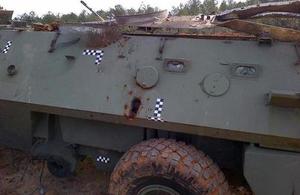Latest battlefield forensics could save lives on the front line
Dstl and US teams work together to apply latest techniques in battlefield forensics

Vehicle damage caused by explosives
Experts at the Defence Science and Technology Laboratory (Dstl) and their US colleagues have developed a system to identify weapons used by the enemy based on after-attack analysis.
Knowing exactly what has been used in an attack can mean changes are made to kit and equipment, to protect against the latest threats and save the lives of soldiers on the front line.
The system involves simple analysis and forensics gathering at the scene – something which is essential to do quickly in a battlefield environment, with more detailed reconstruction and analysis later on, to build a picture of what happened. Everything, from measuring the craters left by explosives to studying the blast patterns of bullets, can be used to accurately identify the weapons used, even down to the country of origin, with each weapon leaving behind a distinct ‘signature’.
The package, funded by Dstl and created in partnership with the US Army National Ground Intelligence Centre (NGIC), is made up of sophisticated algorithms, libraries of collected data and results from live testing, and can provide accurate results quickly – sometimes within an hour of an incident.
Louis Tutin, project manager from the blast and IED team at Dstl, said:
It’s like a fingerprint, we can accurately identify the exact methods used by the enemy, and so can counter it with improved protection for our troops. Before this project, we relied on experience and opinion, now we can back this up with science. You can’t protect against bombs and bullets if you don’t know what the enemy’s using.
The UK has been working on gathering intelligence from attack scenes since the Northern Ireland deployments and since then in Iraq and Afghanistan. This formal bilateral work with the US brings together best practice from organisations like the Metropolitan Police, the CIA and the FBI to inform the high-speed techniques required to gather evidence from a hostile environment.
Col Charles Crowder, from NGIC, said:
Gathering evidence from a crime scene is a painstaking process, which takes time. We don’t have that luxury; we must collect any data we can within two to ten minutes. With our UK partners at Dstl, we can deploy specialist Combat Incident Response teams within 72 hours, who can then study vehicles and the data collected on the ground for detailed analysis.
The system is already in use at Dstl, providing a real-time resource for troops on the ground, and is set to be formally adopted by the MOD in the coming months.
Find out more about Future Threat Programme